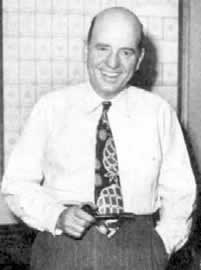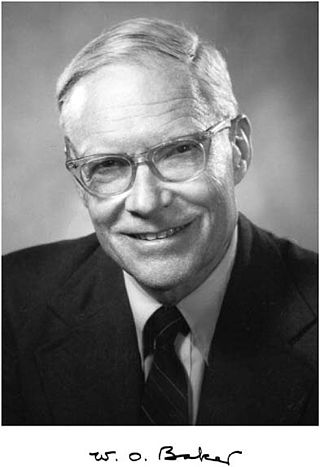
Sir Frederick Augustus Abel, 1st Baronet was an English chemist who was recognised as the leading British authority on explosives. He is best known for the invention of cordite as a replacement for gunpowder in firearms.

Sir William Henry Perkin was a British chemist and entrepreneur best known for his serendipitous discovery of the first commercial synthetic organic dye, mauveine, made from aniline. Though he failed in trying to synthesise quinine for the treatment of malaria, he became successful in the field of dyes after his first discovery at the age of 18.

Herbert Wayne "Herb" Boyer is an American biotechnologist, researcher and entrepreneur in biotechnology. Along with Stanley N. Cohen and Paul Berg, he discovered a method to coax bacteria into producing foreign proteins, which aided in jump-starting the field of genetic engineering.

Charles Martin Hall was an American inventor, businessman, and chemist. He is best known for his invention in 1886 of an inexpensive method for producing aluminum, which became the first metal to attain widespread use since the prehistoric discovery of iron. He was one of the founders of Alcoa, along with Alfred E. Hunt; Hunt's partner at the Pittsburgh Testing Laboratory, George Hubbard Clapp; Hunt's chief chemist, W. S. Sample; Howard Lash, head of the Carbon Steel Company; Millard Hunsiker, sales manager for the Carbon Steel Company; and Robert Scott, a mill superintendent for the Carnegie Steel Company. Together they raised $20,000 to launch the Pittsburgh Reduction Company, which was later renamed Aluminum Company of America and shortened to Alcoa.

George Bogdanovich Kistiakowsky was a Ukrainian-American physical chemistry professor at Harvard who participated in the Manhattan Project and later served as President Dwight D. Eisenhower's Science Advisor.

The Perkin Medal is an award given annually by the Society of Chemical Industry to a scientist residing in America for an "innovation in applied chemistry resulting in outstanding commercial development." It is considered the highest honor given in the US chemical industry.
Warren Kendall Lewis was an MIT professor who has been called the father of modern chemical engineering. He co-authored an early major textbook on the subject which essentially introduced the concept of unit operations. He also co-developed the Houdry process under contract to The Standard Oil Company of New Jersey into modern fluid catalytic cracking with Edwin R. Gilliland, another MIT professor.

Charles Allen Thomas was a noted American chemist and businessman, and an important figure in the Manhattan Project. He held over 100 patents.

Mary Lowe Good was an American inorganic chemist who worked academically, in industrial research and in government. Good contributed to the understanding of catalysts such as ruthenium which activate or speed up chemical reactions.

William Oliver Baker was president of Bell Labs from 1973 to 1979 and advisor on scientific matters to five United States presidents.
Vladimir Haensel was an American chemical engineer who invented the platforming process - a platinum catalytic process for reforming petroleum hydrocarbons into gasoline. In addition, he was influential in the creation of catalytic converters for automobiles.
Milton C. Whitaker (1870-1963) was a noted 20th-century chemist. His areas of speciality were chemical engineering and industrial chemistry.
John H. Sinfelt was an American chemical engineer whose research on catalytic reforming was responsible for the introduction of unleaded gasoline.
Theodore L. Cairns was an American chemist, a member of the National Academy of Sciences, a research scientist at DuPont Central Research, known for his contributions to U.S. scientific policy and applications of chemistry. Cairns was the director of the Central Research Department of E. I. du Pont de Nemours and Company. He was also the chair of the Division of Chemistry and Chemical Technology of the National Research Council, on President Richard Nixon's Science Policy Task Force and Nixon's Science Advisory Committee. His daughter Margaret C. Etter became a noted chemist in her own right, conducting her research at the University of Minnesota.
The Society of Chemical Industry (America Section) or SCI America is an independent learned society inspired by the creation of the Society of Chemical Industry (SCI) in London in 1881. Originally known as the New York Section, it was formed in 1894 and officially renamed the America Section in 1919. The main activity of the America Section is the awarding of several prizes in chemistry: the Perkin Medal, the Chemical Industry Medal and the Gordon E. Moore Medal. The America Section also works with the American Chemical Society (ACS) and others to support scholars in chemistry and chemical engineering.

Ganapati Dadasaheb Yadav is an Indian chemical engineer, inventor and academic, known for his research on nanomaterials, gas absorption with chemical reaction and phase transfer catalysis. He served as the vice chancellor of the Institute of Chemical Technology, Mumbai from 2009 until November 2019. He is currently the Emeritus Professor of Eminence at ICT Mumbai.
The Castner Gold Medal on Industrial Electrochemistry is an biennial award given by the Electrochemical Technology Group of Society of Chemical Industry (SCI) to an authority on applied electrochemistry or electrochemical engineering connected to industrial research. The award is named in honor of Hamilton Castner, a pioneer in the field of industrial electrochemistry, who patented in 1892 the mercury cell for the chloralkali process. Castner was an early member of SCI.
John Douglas Perkins is a retired academic, engineering scientist, and government adviser. He held professorships at Imperial College London and the University of Sydney, served as President of the Institution of Chemical Engineers and was Chief Scientific Adviser to the Department for Business, Innovation and Skills.
Bruce Hornbrook Sage was a chemical engineer who taught chemical engineering at the California Institute of Technology from 1931 to 1974.










